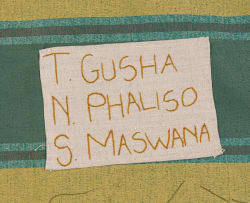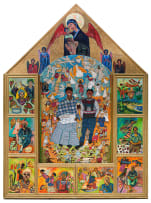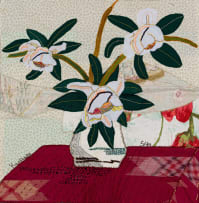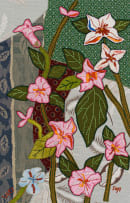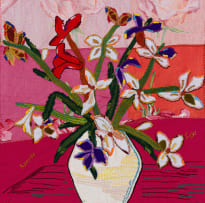Canterbury, from the Sin of Omission series
Keiskamma Art Project
Incl. Buyer's Premium & VAT
About this Item
embroidered with the artists' names, T Gusha, N Phaliso and S Maswana, on a label stitched to the reverse
Notes
Four large tapestries by the Keiskamma Art Project depict key events in the life of Reverend Stephen Mzamane, the main character in A Sin of Omission (Penguin, 2019), the novel by Marguerite Poland. Poland received The Sunday Times Literary Award for the book which is based on a true story. It opens with Stephen (Malusi) Mzamane, a young Anglican priest, journeying to his mother's rural home to inform her of his elder brother's death. First educated at the Native College in Grahamstown, Stephen was sent to England in 1869 for training at the Missionary College in Canterbury. But on his return to South Africa, relegated to a dilapidated mission near Fort Beaufort, he had to confront not only the prejudices of a colonial society but discrimination within the Church itself. Conflicted between his loyalties to the amaNgqika people, for whom his brother fought, and the colonial cause that he, as Reverend Mzamane, is expected to uphold, Stephen's journey to his mother's home proves decisive in resolving the contradictions that tear at his heart.
Seventeen artists from the Keiskamma Art Project were involved in the making of these works, in tribute to Marguerite Poland, a long-time collaborator and close friend of the Project. The themes of her literary works are felt intimately within the communities of the rural Eastern Cape where the Project is based. The artists visited Nondyola, the missionary station to which Stephen was sent on his return from Canterbury, and the site of the Anglican Institution in Grahamstown, in order to understand more fully who Stephen was and what he experienced. Moved by his story and relating to the isolation, conflict and pain Stephen endured, the artists chose scenes from his life to depict as tapestries. The present lot shows the Missionary College in Canterbury where Stephen was sent to prepare for the priesthood and where he forged a close friendship with an English student.
The other three tapestries in the series are Finding Stephen (which depicts the devastation of the Cattle Killing of 1856 and 1857, and shows a missionary finding the starving nine-year-old Stephen), Arriving at Nondyola (which depicts Stephen arriving at Nondyola and seeing for the first time the isolated little church that is to become his parish), and The Maypole Dance (which depicts the church as the Keiskamma artists saw it when they visited in 2019 and were taught a maypole dance by Mrs Lindi Petros, chairperson of the Women's Union).
Founded in 2000, the Keiskamma Art Project in Hamburg, Eastern Cape, produces exquisite textile works, beadwork and wireworks which provide income and other forms of essential support for many families in the area through its cohesive network of women and youth. In particular, in the twenty years since its launch, the project has created a rich oeuvre of tapestries that allow viewers to enter into the conversations of a community of Xhosa women using art as a medium of expression and healing. Their works aid in the archiving of Eastern Cape rural collective memory and the preservation of oral history. The first of their monumental works, the Keiskamma Tapestry, is a large-scale work that was inspired by the famous Bayeux tapestry. It records aspects of the history of South Africa, with a focus on the Eastern Cape, over its 120 metres of length. It now forms part of the Parliament Collection in Cape Town. Other significant works are the Keiskamma Guernica, a South African reinterpretation of Pablo Picasso's 1937 Guernica, and the Keiskamma Altarpiece, which takes Matthias Grünewald's Isenheim Altarpiece (dating from between 1512 and 1516) as its starting point.
The embroideries are a form of storytelling, symbolic micro-histories through which we are given privileged insight into the life of a community at once fragile and resilient. Making art through decades of extreme poverty, and the ravages of HIV/AIDS and Covid-19, the Keiskamma artists weave narratives of hope, at once documenting and transcending the harsh conditions in which their intricate tapestries are created.
The Keiskamma Art Project will be presenting a retrospective exhibition at Constitution Hill, Johannesburg, in 2022, which will give the Keiskamma artists' work the prominent place it deserves, not only in the public imagination, but in the art-historical canon. The work on the current auction, Marriage of Nolulama and Luthando, will also form part of that exhibition.
View all Keiskamma Art Project lots for sale in this auction



